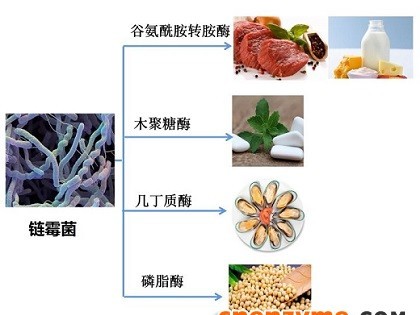The following list, which derives partially from FDA's regulations in Title 21 of the Code of Federal Regulations (21 CFR), includes approved food additives and substances whose GRAS status has been affirmed by FDA. This list includes some ingredients that are not listed in 21 CFR but have been the subject of opinion letters from FDA to individuals who asked whether FDA would object to the use of the ingredient in food on the basis of an independent GRAS determination. In addition, enzyme preparations may be the subject of a GRAS notice. For further information, consult the GRAS Notice Inventory. Because the list below is not updated on a regular basis, questions about the regulatory status of enzyme preparations that are not on this list may be directed to us via electronic mail at premarkt@fda.hhs.gov.
The following is a compilation of enzymes listed as food additives in 21 CFR Part 173. Conditions for their use are prescribed in the referent regulations and are predicated on the use of good manufacturing practices.
To access the specific regulations listed below, type in the title number, 21, and then the section and part numbers, e.g. 173 and 110 on the search page for the Code of Federal Regulations at the Government Printing Office web site.
| Section in 21 CFR | Description of Enzyme Preparation |
|---|---|
| §173.110 | Amyloglucosidase derived from Rhizopus niveus for use in degrading gelatinized starch into constituent sugars. |
| §173.120 | Carbohydrase and cellulase derived from Aspergillus niger for use in clam and shrimp processing. |
| §173.130 | Carbohydrase derived from Rhizopus oryzae for use in the production of dextrose from starch. |
| §173.135 | Catalase derived from Micrococcus lysodeikticus for use in the manufacture of cheese. |
| §173.140 | Esterase-lipase derived from Mucor miehei var. Cooney et Emerson as a flavor enhancer in cheeses, fats and oils, and milk products. |
| §173.145 | α-galactosidase derived from Mortierella vinaceae var. raffinoseutilizer for use in the production of sucrose from sugar beets. |
| §173.150 | Milk-clotting enzymes, microbial for use in the production of cheese (Milk-clotting enzymes are derived fromEndothia parasitica Bacillus cereus, Mucor pusillus Lindt and Mucor miehei Cooney et Emerson andAspergillus oryzae modified to contain the gene for aspartic proteinase from Rhizomucor miehei varCooney et Emerson). |
The following food standard lists a permitted enzyme preparation
| Section in 21 CFR | Description of Food |
|---|---|
| §137.105 | Flour may contain α-amylase obtained from the fungus Aspergillus oryzae. |
Please be aware that FDA has not affirmed as GRAS all food ingredients that it may consider GRAS. Therefore, the table below does not represent a complete list of all enzymes that FDA may view as GRAS for some uses.
The following is a compilation of enzymes that have been affirmed as GRAS by FDA for specified or unspecified food uses and listed in 21 CFR Part 184. Conditions for their use are prescribed in the referent regulations and are predicated on the use of nontoxicogenic strains of the respective organisms and on the use of current good manufacturing practice (184.1(b)).
| Section in 21 CFR | Description of Enzyme Preparation |
|---|---|
| §184.1012 | Alpha-amylase enzyme preparation from Bacillus stearothermophilus used to hydrolyze edible starch to produce maltodextrin and nutritive carbohydrate sweeteners. |
| §184.1024 | Bromelain derived from pineapples, Ananas comosus and Ananas bracteatus used to hydrolyze proteins and polypeptides. |
| §184.1027 | Mixed carbohydrase and protease enzyme product derived from Bacillus licheniformis for use in hydrolyzing proteins and carbohydrates in the preparation of alcoholic beverages, candy, nutritive sweeteners and protein hydrolysates. |
| §184.1034 | Catalase from bovine liver used to decompose hydrogen peroxide |
| §184.1316 | Ficin (peptide hydrolase) from the genus Ficus to hydrolyze proteins and polypeptides. |
| §184.1372 | Insoluble glucose isomerase enzyme preparations are derived from recognized species of precisely classified, nonpathogenic, and nontoxicogenic microorganisms, including Streptomyces rubiginosus,Actinoplane missouriensis, Streptomyces olivaceus, Streptomyces olivochromogenes and Bacillus coagulans grown in a pure culture fermentation that produces no antibiotic. |
| §184.1387 | Lactase enzyme preparation from Candida pseudotropicalis for use in hydrolyzing lactose to glucose and galactose. |
| §184.1388 | Lactase enzyme preparation from Kluyveromyces lactis (previously called Saccharomyces lactis) for use in hydrolyzing lactose in milk. |
| §184.1415 | Animal lipase (triacylglycerol hydrolase) derived from the edible forestomach of calves, kids or lambs used to hydrolyze fatty acid glycerides. |
| §184.1420 | Lipase enzyme preparation from Rhizopus niveus used in the interesterification of fats and oils. |
| §184.1443 | Malt (α-amylase and β-amylase) from barley to hydrolyze starch. |
| §184.1583 | Pancreatin (peptide hydrolase) from porcine or bovine pancreatic tissue used to hydrolyze proteins or polypeptides. |
| §184.1585 | Papain derived from papaya, Carica papaya L. . |
| §184.1595 | Pepsin (peptide hydrolase) from hog stomach used to hydrolyze proteins. |
| §184.1685 | Rennet (animal derived) and chymosin preparation from Escherichia coli K-12, Kluyveromyces marxianusvar. lactis or Aspergillus niger var. awamori to coagulate milk in cheeses and other dairy products. |
| §184.1914 | Trypsin (peptide hydrolase) from porcine or bovine pancreas used to hydrolyze proteins. |
| §184.1924 | Urease enzyme preparation from Lactobacillus fermentum for use in the production of wine. |
| §184.1985 | Aminopeptidase enzyme preparation from Lactococcus lactisused as an optional ingredient for flavor development in the manufacture of cheddar cheese. |
The following is a compilation of microbially derived enzymes which the FDA recognized as GRAS in opinion letters issued in the early 1960's. The opinions are predicated on the use of nonpathogenic and nontoxicogenic strains of the respective organisms and on the use of current good manufacturing practice.
| Description of Enzyme Preparation |
|---|
| Carbohydrase, cellulase, glucose oxidase-catalase, pectinase, and lipase from Aspergillus niger |
| Carbohydrase and protease from Aspergillus oryzae |
| Carbohydrase and protease from Bacillus subtilis |
| Invertase from edible baker's yeast or brewer's yeast (Saccharomyces cerevisiae) |




